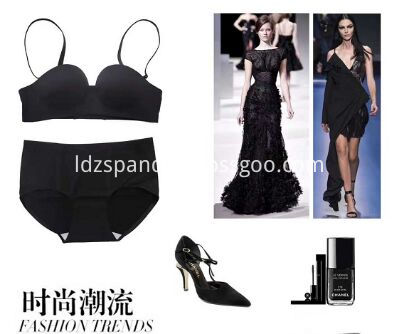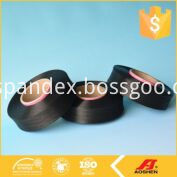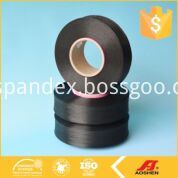Black Spandex is Aoshen® spandex yarn, AOSHEN brand is well known in China. Like lycra fabric, It`s an elastic fiber.
Heat-resistant Black Spandex provides excellent processing properties to clients. Its elasticity and strength can remain above 80% after dyeing under 135℃.
Advantage:
1. The dyeing temperature can reach 135℃, sacking time is less than 45min, terminal-setting temperature can 185℃,and the action time is less than 50s.
2. Can effectively prevent the spandex yarn from break during dyeing under high temperature.
3. Big elastic elongation, high intensity and good recovering effect.
Application:
Widely applied to knitting, weaving and covering, especially suit for socks and underwear with dark color.
Black Spandex Black Spandex,Different Styles Black Spandex,Elastic Black Fabrics Spandex,Black Stretch Fabrics Spandex LDZ New Aoshen Spandex Co.,Ltd. , http://www.ldzspandex.com
"Not all companies are suitable for joining."
Clothing Times: Why do domestic garment companies take the old road of agency distribution? What are the characteristics of the real franchise chain model?
Wu Ruiling: The basic characteristics of the franchise chain are unified image, unified purchase, unified delivery, and unified price. If we observe this definition, most of the domestic apparel companies' franchise chain models cannot be called chain operations.
Most of the apparel industry's franchisees implement a buyout system when they purchase the goods. The sales volume has nothing to do with the brand business. Agency distribution is more about earning commissions and spreads in a trade manner. From the perspective of the franchise model, this approach is Failure. The relationship between franchisees and franchisees is more like a "marriage" relationship, similar to a family combination.
Clothing Times: Why did China not have a successful franchise chain company?
Wu Ruiling: The fundamental reason is that the enterprise's mastery and understanding of the joining mode is not in place. A few years ago, at the international conference, I emphasized that chain operations must have four elements that can be summarized as "BOSS."
The first is the request of the brand (BRAND). The chain headquarters needs to be able to provide franchisees with a strong brand; secondly, there must be a set of standardized processes for standardization in the OPERATION. For example, a successful KFC in the restaurant industry has a 600-700 page manual. This requires the chain headquarters to constantly summarize and refine the daily work experience to standardize it. China currently has no mandatory standards for chain operations. Once again, the chain headquarters oversees and supports the franchisees (SUPPORT). The last point is also the goal pursued by the chain of operations, that is, from the headquarters to the franchisees to form an efficient operating system (SYSTEM).
Garment Times: The chain headquarters must have a strong, appealing brand. The reality is that many new brands will join franchisees as soon as they come out. They hope to rely on the strength of franchisees to expand the market.
Wu Ruiling: The reason why franchisees join is because they are weak, and he hopes to gain operating profits under the brand's mature operating system and support system. However, many domestic brands want agents and franchisees to have a wide range of market resources for sales. If the sales of goods do not go out, brand owners are not responsible. This is totally unfair.
McDonald's has more than 90% of the more than 30,000 stores in the world are franchised stores. Its franchise model has been in place for more than 60 years. More than 70% of McDonald's domestic stores in the United States are McDonald's owned properties or leased to franchisees for long-term rental, and franchisees can also pass the stores as heritage to the next generation.
In addition, McDonald's supply chain construction is also in place, suppliers are all year-round cooperation with McDonald's, McDonald's where to go, where the supplier will follow. It uses a unique property, supply chain, unified advertising and other policies to make the joining mode both close and dynamic.
Clothing Times: Many clothing companies are gradually cutting franchise stores and expanding the proportion of direct operations. How do you view this phenomenon?
Wu Ruiling: In addition to some of the more prominent fashion and leisure brands on the domestic market, the mode of chain operation in China's garment industry seems to be in a difficult position. However, as the market and companies continue to mature, companies are constantly exploring and honing to find a suitable business model. Its own operating model, I believe it will give birth to a number of franchise chain of leading companies.
Apparel companies should start from the long-term and can invest funds in system design and R&D, supply chain system and channel management, etc. This is the precondition for the success of the franchise model.
If the product has a strong financial strength and a wide range of influence, it can insist on a direct operating model. From the perspective of capital, when the R&D capability of such enterprises is strong enough and the operating system is perfect enough, capital will naturally chase after the capital strength. The intervention is a good thing for companies that adhere to the self-support model. Relative to the franchise, I am more optimistic about the direct chain, nowadays well-developed clothing brand is best to insist on direct, rather than joining. Not eager for quick success and instant benefits, without external interference, and persistently studying their own brands, products and consumers, this is a necessary way for the direct chain to succeed.
"The true sense of the clothing store is still blank."
Clothing Times: Which brands in the world are doing better in chain operations?
Wu Ruiling: France, Spain's clothing franchising model is doing very well. Mango is developed in the form of franchise, and ZARA is also predominantly joined in the early stages, and gradually evolves into a form of joining and direct management. This model is particularly reflected in the second and third line brands.
First of all, from the analysis of the format itself, the brand stores are dominated by the franchise model; while the category specialty stores, the typical brand C&A is dominated by direct sales, and the popular one is the multi-category garment collection department store. And this kind of shop is almost absent in China, that is, the real sense of the clothing store is still blank.
Clothing Times: Are you talking about a chain-type clothing store?
Wu Ruiling: There are few professional clothing retail stores. Although the department store is dominated by clothing, there are still other products; although brand stores are clothing stores, they are not integrated clothing stores.
Domestic department stores in fact do not assume the role of retailers, but rather brand dealers or agents are doing retail work. Therefore, what appears before our eyes is that brand owners open clothing stores. Whether they are in a commercial street or a department store, brand owners are still the dominant players, and they distribute their own goods and recruit shopping guides.
In China, clothing retailers such as British Primark and German P&C have not yet appeared. P&C is Germany's second largest clothing retail chain, second only to C&A. With a store area of ​​40,000 square meters, it combines multiple brands and categories such as men's, women's, children's wear, and elderly clothes, and integrates multiple supplier brands. Each floor is accompanied by an associated category for sale. The layout of the store is divided horizontally by category and vertically by the rules of the brand and in order to facilitate consumers to purchase. This form of retailing is almost nonexistent in China. Such a large-scale, multi-category shop must be made by a clothing retailer, while it can include its own brand.
Primark, which has risen in the UK, is also a true clothing retailer. It integrates a number of brands. I call it a “fashion hard discount store,†while P&C is a regular retail. Primark has a number of trend brands, the price of goods is extremely cheap, but it is different from similar broken outlets such as Outlets, top grade discount stores, commodities are all new trends.
Clothing Times: According to the current situation, excellent clothing agents are most likely to grow into large clothing retailers?
Wu Ruiling: Domestic large-scale clothing agents and brand dealers are facing a transformation. Innovation in the format is necessary and possible. Although the brand belongs to the domestic market, it also needs to learn from foreign experience and practices. It is believed that China's Primark will appear in clothing retailers. 





![@$8]JTLTJ2ZRE`V_2[3[I%1 @$8]JTLTJ2ZRE`V_2[3[I%1](http://i.bosscdn.com/product/45/ef/c0/7b0c3efabcc7e9d36b1d944d0d.jpg@watermark=2&color=I0ZGRkZGRg%3D%3D&type=ZHJvaWRzYW5zZmFsbGJhY2s%3D&size=22&p=5&t=80&text=bGR6c3BhbmRleC5ib3NzZ29vLmNvbQ%3D%3D)
Franchising is favored by many companies because of its advantages of reducing investment in capital and manpower, and quickly occupying target markets at low cost. Thus, from the 90s of the last century, domestic garment companies, regardless of size, regardless of strength, have issued investment advertisements to seek franchisees. However, according to Wu Ruiling, deputy secretary-general of the China Chain Store Management Association, many apparel companies have played the slogan of “developing franchiseesâ€, but in fact they are still “new bottled laoquâ€, calling for a chain model and taking the path of agency distribution.
September 26, 2019